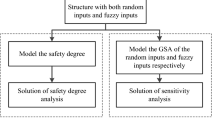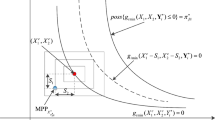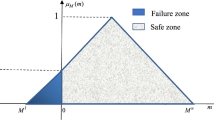Abstract
The analyses of safety degree and sensitivity for structure are significant in engineering. For the time-dependent structure involving both random and fuzzy inputs, two indices named as the fuzzy time-dependent failure probability and the random time-dependent failure possibility are presented to measure safety degree of time-dependent structure from different aspects, i.e., the fuzzy time-dependent failure probability measures safety degree from the probabilistic view and the random time-dependent failure possibility measures safety degree from the non-probabilistic view. For efficiently estimating these two indices, Genetic Algorithms (GA) is employed. Furthermore, Sparse Grid (SG) technique combined with fourth-moment method is used to estimate the fuzzy time-dependent failure probability. Based on these two safety degree indices, two global sensitivity indices are established. By considering different aspects of the output, the importance ranking of the inputs can be obtained from these two established global sensitivity models. Some efficient procedures are proposed to estimate the global sensitivity indices by combining the three-point estimation method. Several examples containing the numerical and engineering ones are listed to illustrate the effectiveness of the proposed procedures for estimating the two safety degree indices and the two global sensitivity indices.













Similar content being viewed by others
References
Bai YC, Han X, Jiang C (2014) A response-surface-based structural reliability analysis method by using non-probability convex model. Appl Math Model 38(15–16):3834–3847
Belisle CJP (1992) Convergence theorems for a class of simulated annealing algorithm on Rd. J Appl Probab 29(4):885–895
Borgonovo E (2007) A new uncertainty importance measure. Reliab Eng Syst Saf 92(6):771–784
Carlsson C, Fuller R (2001) On possibilistic mean value and variance of fuzzy numbers. Fuzzy Sets Syst 122(2):315–326
Cremona C, Gao Y (1997) The possibilistic reliability theory: theoretical aspects and applications. Struct Saf 19(2):173–201
Du X (2014) Time-dependent mechanism reliability analysis with envelope functions and first-order approximation. J Mech Des 136(136):081010
Fan C, Lu ZZ, Shi Y (2018) Safety life analysis under the required failure possibility constraint for structure involving fuzzy uncertainty. Struct Multidiscip Optim 58(1):287–303
Gao P, Yan SZ, Xie LY (2014) Dynamic fuzzy reliability models of degraded hold-down structures for folded solar array. Appl Math Model 38(17–18):4354–4370
Groenwold AA, Etman LFP (2010) On the conditional acceptance of iterates in SAO algorithms based on convex separable approximations. Struct Multidiscip Optim 42(2):165–178
Hawchar L, Soueidy CPE, Schoefs F (2015) Time-variant reliability analysis using polynomial chaos expansion. 12th International Conference on Applications of Statistics and Probability in Civil Engineering, ICASP12, Vancouver, Canada
He J, Gao S, Gong J (2014) A sparse grid stochastic collocation method for structural reliability analysis. Struct Saf 51:29–34
Huang ZL, Jiang C, Zhou YS (2017) Reliability-based design optimization for problems with interval distribution parameters. Struct Multidiscip Optim 55(2):513–528
Hu W, Choi KK, Cho H (2016) Reliability-based design optimization of wind turbine blades for fatigue life under dynamic wind load uncertainty. Struct Multidiscip Optim 54(4):1–18
Hu Z, Du X (2013) Time-dependent reliability analysis with joint upcrossing rates. Struct Multidiscip Optim 48(5):893–907
Hu Z, Li H, Du X (2012) Simulation-based time-dependent reliability analysis for composite hydrokinetic turbine blades. Struct Multidiscip Optim 47(5):765–781
Hu Z, Mahadevan S (2016) A single loop kriging surrogate modeling for time-dependent reliability analysis. J Mech Des 138(6):061406
Hu Z, Mahadevan S (2015) Global sensitivity analysis-enhanced surrogate (GSAS) modeling for reliability analysis. Struct Multidiscip Optim 53(3):1–21
Jiang C, Huang XP, Han X et al (2014) A time-variant reliability analysis method based on stochastic process discretization. J Mech Des 136(9):091009
Keshtegar B, Kisi O (2017) M5 model tree and monte carlo simulation for efficient structural reliability analysis. Appl Math Model 48:899–910
Kumar M, Yadav SP, Kumar S (2013) Fuzzy system reliability evaluation using time-dependent intuitionistic fuzzy set. Int J Syst Sci 44(1):50–66
Lacaze S, Brevault L, Missoum S, Balesdent M (2015) Probability of failure sensitivity with respect to decision variables. Struct Multidiscip Optim 52(2):375–381
Lee I, Choi KK, Noh Y, Lamb D (2013) Comparison study between probabilistic and possibilistic methods for problems under a lack of correlated input statistical information. Struct Multidiscip Optim 47(2):175–189
Li J, Chen JB, Fan WH (2007) The equivalent extreme-value event and evaluation of the structural system reliability. Struct Saf 29(2):112–131
Li L, Lu ZZ, Cheng L, Wu D (2014) Importance analysis on the failure probability of the fuzzy and random system and its state dependent parameter solution. Fuzzy Sets Syst 250(2):69–89
Li L, Lu ZZ, Feng J, Wang B (2012) Moment-independent importance measure of basic variable and its state dependent parameter solution. Struct Saf 38(38):40–47
Li L, Lu ZZ (2017) Variance-based sensitivity analysis for models with correlated inputs and its state dependent parameter solution. Struct Multidiscip Optim 56(4):919–937
Malhotra R, Singh N, Singh Y (2011) Genetic algorithms: concepts, design for optimization of process controllers. Computer and Information Science 4(2):39–54
Marano GC, Quaranta G, Mezzina M (2008) Fuzzy time-dependent reliability analysis of RC beams subject to pitting corrosion. J Mater Civ Eng 20(9):578–587
Meng Z, Li G, Yang D, Zhan L (2017) A new directional stability transformation method of chaos control for first order reliability analysis. Struct Multidiscip Optim 55(2):601–612
Qiu Z, Wang X (2010) Structural anti-optimization with interval design parameters. Struct Multidiscip Optim 41(3):397–406
Rice SO (2015) Mathematical analysis of random noise. Bell Syst Tech J 24(1):46–156
Schrupp K, Rackwitz R (1988) Outcrossing rates of marked poisson cluster processes in structural reliability. Appl Math Model 12(5):482–490
Shi Y, Lu ZZ, Cheng K, Zhou Y (2017a) Temporal and spatial multi-parameter dynamic reliability and global reliability sensitivity analysis based on the extreme value moments. Struct Multidiscip Optim 56(1):117–129
Shi Y, Lu ZZ, Chen SY, Xu L (2018) A reliability analysis method based on analytical expressions of the first four moments of the surrogate model of the performance function. Mech Syst Signal Process 111:47–67
Shi Y, Lu ZZ, Zhang K, Wei Y (2017b) Reliability analysis for structures with multiple temporal and spatial parameters based on the effective first-crossing point. J Mech Des 139(12):121403
Shi Y, Lu ZZ, Zhou Y (2017c) Global sensitivity analysis for fuzzy inputs based on the decomposition of fuzzy output entropy. Eng Optim 4:1–19
Song SF, Lu ZZ, Li W, Cui L (2014) The uncertainty importance measures of the structural system in view of mixed uncertain variables. Fuzzy Sets Syst 243:25–35
Sudret B, Der Kiureghian A (2000) Stochastic finite element methods and reliability: a state-of-the-art report. Department of Civil and Environmental Engineering, University of California, Berkeley 30:22–25
Tosserams S, Etman LFP, Rooda JE (2009) A classification of methods for distributed system optimization based on formulation structure. Struct Multidiscip Optim 39(5):503–517
Wang L, Wang X, Wu D, Xu M, Qiu Z (2018) Structural optimization oriented time-dependent reliability methodology under static and dynamic uncertainties. Struct Multidiscip Optim 57(4):1533–1551
Wang Z, Wang P (2012) A nested extreme response surface approach for time-dependent reliability-based design optimization. J Mech Des 134(12):121007
Wei PF, Song JW, Lu ZZ (2016) Time-dependent reliability sensitivity analysis of motion mechanism. Reliab Eng Syst Saf 149:107–120
Winslow P, Pellegrino S, Sharma SB (2010) Multi-objective optimization of free-form grid structures. Struct Multidiscip Optim 40(1–6):257–269
Zadeh LA (1978) Fuzzy sets as a basis for a theory of possibility. Fuzzy Sets Syst 1(1):3–28
Zhang DQ, Han X, Jiang C, Liu J, Long X (2015) The interval PHI2 analysis method for time-dependent reliability. Scientia Sinica Physica, Mechanica and Astronomica 45(5):054601
Zhang DQ, Han X, Jiang C, Liu J, Li Q (2017) Time-dependent reliability analysis through response surface method. J Mech Des 139(4):041404
Zhang L, Lu Z, Chen J (2014) An efficient method for failure probability-based moment-independent importance measure. Acta Aeronautica Et Astronautica Sinica 35(8):2199–2206
Zhang J, Gong S, Huang Y, Qiu A, Chen R (2008) Structural dynamic shape optimization and sensitivity analysis based on RKPM. Struct Multidiscip Optim 36(3):307–317
Zhao YG, Ono T (1999) A general procedure for first/second-order reliability method (FORM/SORM). Struct Saf 21(2):95–112
Zhao Y, Lu Z (2007) Applicable range of the fourth-moment method for structural reliability. Journal of Asian Architecture and Building Engineering 6(1):151–158
Zhou CC, Lu ZZ, Zhang LG (2014) Moment independent sensitivity analysis with correlations. Appl Math Model 38(19–20):4885–4896
Acknowledgements
This work was supported by the Natural Science Foundation of China (Grant Nos. 51475370 and 51775439).
Author information
Authors and Affiliations
Corresponding author
Additional information
Responsible Editor: Byeng D Youn
Rights and permissions
About this article
Cite this article
Shi, Y., Lu, Z. & Zhou, Y. Time-dependent safety and sensitivity analysis for structure involving both random and fuzzy inputs. Struct Multidisc Optim 58, 2655–2675 (2018). https://doi.org/10.1007/s00158-018-2043-y
Received:
Revised:
Accepted:
Published:
Issue Date:
DOI: https://doi.org/10.1007/s00158-018-2043-y




